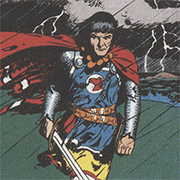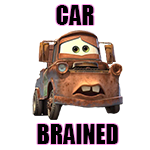|
Major: has a major 3, 6, or 7 in it somewhere Minor: has a minor 3, 6, or 7 in it somewhere Other: does not have a 3, 6, or 7 in it, or sometimes has a mixed combo of major/minor attributes. Can be considered one or the other depending on context or strength of the root/voicing Edit: for example, a power chord is neither major or minor, but can be considered one or the other in terms of what other power chords are in the progression Spanish Manlove fucked around with this message at 04:59 on Dec 9, 2020 |
|
|
|

|
| # ? May 21, 2024 23:48 |
|
Spanish Manlove posted:dude come on, knowing the difference between major, minor, and "other" is loving day one level poo poo you should know. Yeah this isn't "instictively knowing how to play an Ebdim7add9add#11 to get unprecedented levels of snapping from your improv jazz open mic audience" stuff, this is "how I do into music".
|
|
|
|
I forgot about my homie the 2 aka the 9 but that's some advanced level jazz poo poo that will make people's brains explode
|
|
|
|
could anyone give advice for getting rid of string noise? whenever I record I feel like there's a lot of string noise as I move my fingers. I can play in time and jump cleanly but there's that little bit of scraping and it's in no one else's playing that I can hear, even live recordings -- what am I doing wrong?
|
|
|
|
You start telling me 2=9 an I'm gonna start telling you to get hosed, jazz nerd. E: speaking of jazz nerd landgrabber posted:could anyone give advice for getting rid of string noise? I play flats on everything, even the mandolin. Flats rock. Huxley fucked around with this message at 05:09 on Dec 9, 2020 |
|
|
|
Huxley posted:You start telling me 2=9 an I'm gonna start telling you to get hosed, jazz nerd. Lol I know a 2 isn't the same as a 9, functionally, but it's the same note and I'm lazy at notation. I've been playing more with c shape sus2 voicings as opposed to the torture chord voicing and it's nice to have another tool in the box. It's not better but it's different enough to get some cool usage, like switching from a c shape triad to a c shape sus2 for a sort of feeling like the guitar is losing confidence in itself. I came up with the idea while messing around in Emaj then eventually realized that the same idea is used in Metallica - Orion and Dissection - The somberlain but in Eminor so whatever man Spanish Manlove fucked around with this message at 05:19 on Dec 9, 2020 |
|
|
|
Without the 9 there is no 6/9 chord and I don't wanna live in that reality
|
|
|
|
oh and there're two things I felt like it wasn't sophisticated for a while to play power chords, or like, it was bad, but I've shifted around on it. the worse things is actually to play barre shapes everywhere, that take up so much space sonically, that always have the third as the highest note. it's gonna be super hard to write a melody around that if you're only in chords where the highest note is the third and it's in like the fourth octave. power chord stuff led me to a couple different inversions, just from playing weezer songs (like using 3355XX to play C, or even just 335XXX, or playing D like 554XXX), and that led me to intervals. so same sort of advantage of power chords where you're getting two notes that are closely put together, but you can get a little more melodic by doing like, a first and a third, or a first and a sixth, and then moving those around, and having slower sort of static background melodies, instead of huge chords. and it seems like most guitar parts I run into anyway even in songs I really like are just like that -- power chords or intervals being moved around, not huge blocks of chords. it's really pretty rare that you get those. I never really liked the rock/jazz/blues thing unless something else was being done to it (weezer's rigid structure and emphasis on vocal melody for instance) so what I've been doing and what I've really been enjoying doing is playing the guitar more like a piano or a classical instrument or something. thinking about the way notes move to each other or "should" move to each other and playing that on guitar, rather than letting the same guitar moves everybody does just murder the composition. I guess a lot of this is pretty obvious but I feel like I'm getting closer to having a path to playing the instrument in a way that's mine and a way that I like, and maybe I won't grow old and be playing pentatonic licks (jokes on them: I never learned the pentatonic scale, I went straight to major and minor)
|
|
|
|
Since picking up guitar and taking to my friends I have realized music literacy is way less common than I assumed. It was compulsory at my school to take either band or orchestra for two years and I thought that was pretty common, though my wife played flute and still remember nothing. I played violin and don't remember a ton but what I do remember has been helpful in understanding and learning guitar. I dunno if you need deep understanding of music theory to get good guitar but I feel like you should maybe at least know your chords, especially if you're trying to give advice. Unless you're just like, making shapes across the fretboard in DADGAD
|
|
|
|
I an unsure of whether this was the best place to put this or not but it is guitar, just amp/pedal situation I am running into. I have an oooold Line 6 Spyder 210 Red faced amp that I bought 20+ years ago. It has worked for my needs of playing faux Guitar Hero in my home/apartment during that time. I had been using it with a 4 switch mini board that attaches via Cat5 Cable. This weekend I was browsing some used gear at local shops and found an old Floorboard that I wanted ages ago but was like $500. Picked it up yesterday for $100. The issue I am having is that amp with no connection is at volumes I am familiar with, but plugging in the board puts everything at like 1% volume. Cranking every knob MAYBE gets me 5-10% volume that I am used to. The manual from the Line 6 legacy pages does not offer much in the way of adjusting the sound that I have found so far. This is with the volume pedal toe down, and occurs whether any other pedals/effects plugged in or not. Anyone have any experience with this? I anticipate not, as the Line 6 "forums" are basically dead. I may reach out to Line 6 in the future, but figured I could ask around here.
|
|
|
|
Spanish Manlove posted:dude come on, knowing the difference between major, minor, and "other" is loving day one level poo poo you should know. Well yea, i thought xx0235 was a major chord, that 5th fret is an A so its major. If it was F on the 6th string instead of A thats minor. See  Yea I just look at the scales, Thats super important, I am not great at it by any means though Cheese Thief fucked around with this message at 19:16 on Dec 9, 2020 |
|
|
|
Spanish Manlove posted:Major: has a major 3, 6, or 7 in it somewhere I know you know what you're talking about but it goes over my head. I'm really visual so I have to picture a piano keyboard in my head, or the notation, even when I play guitar. I think its because I started at piano at like 5 years old so Im stuck in my habits. But Respect to you by all means
|
|
|
|
Cheese Thief posted:Well yea, i thought xx0235 was a major chord, that 5th fret is an A so its major. If it was F on the 6th string instead of A thats minor. See The notes are xxDADA That's root, fifth, octave, 13(or octave of fifth) which is neither major or minor because both have those exact same notes. That fifth does not make it major at all. If you looked at scales and actually knew what the hell you were talking about you'd actually know this super basic poo poo.
|
|
|
|
Cheese Thief posted:Well yea, i thought xx0235 was a major chord, that 5th fret is an A so its major. If it was F on the 6th string instead of A thats minor. See xx0235 is neither major nor minor because the voicing lacks a third. The A is acting as a fifth in relation to your root of D in this example. If you add an F to this chord, it will become a D minor. If you change that F to an F#, it will become a D major. e:f,b
|
|
|
|
Spanish Manlove posted:The notes are xxDADA It's very obviously an inverted Asus4 (no 5th)
|
|
|
|
Lester Shy posted:xx0235 is neither major nor minor because the voicing lacks a third. The A is acting as a fifth in relation to your root of D in this example. If you add an F to this chord, it will become a D minor. If you change that F to an F#, it will become a D major. Ok, so seriously what do you think of just playing within the scale? I really never realized how different a guitarist mindset is fron piano until recently, unless I just don't know what I'm talking about which is entirely possible. My piano teacher was a very strange woman the taught me by memorization. I don't even know what a fifth mean, is that 5 half steps? I might just keep quiet since I am ignorant to it, but I dont think I'd benefit any in my playing to be quite honest by knowing it. Sight reading is my big goal in the long term. Thank you
|
|
|
|
Spanish Manlove posted:The notes are xxDADA But D A D A are all within that D major scale? I'll stop talking about it and play more lol im getting embarressed. Believe it or not i am an ok guitar player
|
|
|
|
Cheese Thief posted:Ok, so seriously what do you think of just playing within the scale? I really never realized how different a guitarist mindset is fron piano until recently, unless I just don't know what I'm talking about which is entirely possible. My piano teacher was a very strange woman the taught me by memorization. I don't even know what a fifth mean, is that 5 half steps? I might just keep quiet since I am ignorant to it, but I dont think I'd benefit any in my playing to be quite honest by knowing it. Sight reading is my big goal in the long term. Thank you It sounds like you got a weird piano education, regular piano method introduces chords as soon as you learn scales. But if you know your scales well, you already know a bunch of chords because they are built in 3rds. The fifth is the fifth note in whatever scale you are talking about, so in the key of C the fifth is G. The C major chord is 1-3-5, so CEG And if you're playing within the scale and build other chords in thirds, you get minor chords naturally. ACE is 6-1-3 and is a minor chord as you can probably hear.
|
|
|
|
Cheese Thief posted:But D A D A are all within that D major scale? I'll stop talking about it and play more lol im getting embarressed. Believe it or not i am an ok guitar player They are also in the D minor scale. And in D Dorian, D Phrygian, D Lydian, D Mixolydian, D Melodic Minor, D Harmonic Minor, etc. etc. etc. The 3rd degree of the scale determines it's "minorness" If the 3rd degree is two whole steps away, (F# in the case of D) then you have a major chord / scale. If the 3rd degree is one and a half steps away (F in the case of D) then you got yourself a minor. None of the other scale degrees matter so much. If there is no 3rd degree in a chord (as in the case of DADA, which is just the root and fifth degree) then you cannot tell if it's major on minor.* * It could be implied by the melody or other chords however, but on its own, you can't tell.
|
|
|
|
the naturally occurring triads within a scale are called the diatonic chords: https://www.studybass.com/lessons/harmony/what-are-major-scale-diatonic-chords/
|
|
|
|
Ok, so I may be a little hostile so let me back it off a little bit and try to be constructive without being a condescending dick. Ok so contemporary western scales are built on a system 12 notes each separated by a semitone. Two semi make a whole. The major scale is made from a specific series of these intervals: whole whole half whole whole whole half. Ok so let's pick an easy one, starting from C let's build the scale. C whole D whole E half F whole G whole A whole B half C In that list we now have specific intervals. So a major third is always who whole steps away, a major sixth is four and a half whole steps away, and a major seventh is eleven and a half away. In contemporary western scales, the other ones are derived from that exact same pattern but with a different starting point. So if your pattern is CDEFGAC but you start on the A, you get ABCDEFGA. This is known as the minor scale. Let's break that down now: A whole B half C whole D whole E half F whole G whole A The exact same logic applies for the scale degrees of the minor scale, so a third is one and a half rather than two away etc. But if you pay attention, the fourth fifth and octaves are the exact same interval apart. The same pattern but starting on other notes gets other scales, which have combinations of major and minor elements so they sit in between the two.
|
|
|
|
If you want to practice this on the piano, those are all the white keys. The interval between each key (black and white) is a half step. The interval from one fret to another is a half step too. That's why the twelfth fret is the octave and two C keys are 12 keys apart.
|
|
|
|
this thread rn: https://www.youtube.com/watch?v=u0K2F2DQz_I
|
|
|
|
Thanks for dialing back the hostility and making a good effortpost on basic stuff. I'm just going to dumb it down another couple of notches: chords, in my mind come in four basic versions:
Basically, if it sounds neither happy, sad or weird, it's a power chord, which just has essentially the two most boring notes in the scale, the root note and the fifth, which from a physics perspective is just half an octave and thus sounds pretty boring. There can be octaves of both notes in the chord, it still sound pretty boring. Your xx0235 is one of these power chords, as is 5577xx or, in my opinion, x00xxx, especially in the context of Smoke on the Water. My point is, rather than analyzing the chord, try to figure out the mood of it instead and use that. But it helps the bass player a lot of your can say "yeah, it's D minor, F major and two bars of C# major "or whatever, so she knows what to play towards.
|
|
|
|
I think the issue is Major Scale vs Major Chord. Major scales have the WWHWWWH setup. So for example the key of D Major is D, E, F#, G, A, B, C. Major chords have the 3rd of that note's major scale in them (also called the major third interval). The third scale degree of the D major scale is F#, so the chord Dmaj is D, F#, and A. Minor chords have the flatted third (or minor third interval). So the chord Dmin is D, F, and A. Whether a given chord is in (or "diatonic to") a key is determined by whether all of that chord's notes are in the key. So Dmaj is diatonic to the D Major scale. Dmin is not diatonic to the D Major scale because F is not in the D Major scale. If your chord has neither a major or minor third interval, then it is neither a major nor minor chord. ADAD has no third, it's just first and fifths, so it's not a major or minor chord. All of the chords that are diatonic to the D Major scale are D, Em, F#m, G, A, Bmin, and Cdim.
|
|
|
|
Just play whatever the lowest note is fast, only downstrokes and palm mute. No theory needed, just gain.
|
|
|
|
Cheese Thief posted:But D A D A are all within that D major scale? I'll stop talking about it and play more lol im getting embarressed. Believe it or not i am an ok guitar player I'm transposing everything here to C Major because it's easier to talk about, but everything applies to the DADA chord. The C Major scale is made up of the notes CDEFGAB. If you assign each note in the scale a number, you get this: code:You build the chords of the C Major scale by starting on a note, skipping one, adding the third, skipping one and adding the fifth. This is called "stacking thrids," because each successive note is a third away from the previous note. Each basic chord (also known as a triad because it is comprised of three stacked thirds) in the scale is made up of a root, a third and a fifth. The third is what gives each chord its primary character, its majorness or minorness. The first chord of the C Major scale is (obviously) C Major, and it's made up of the notes C, E and G. You can see this easily on the piano because you play most of your basic beginner chords like this:  You see how the chord is made by combining the first, third and fifth notes of the C major scale (aka all the white keys)? If you pick up your hand, take that simple three finger shape and shift the whole thing up by one white key, you get the second chord of the C Major scale, D minor, which is made up of the notes D, F and A. All of the diatonic triads of a given scale are built this way. If you keep moving that shape up by a white key, you get all of the chords of the C Major scale: C Maj, D Min, E Min, F Maj, G Maj, A Min, B Dim. Please tell me if I got anything here wrong, I've just started teaching myself this stuff over the past few months.
|
|
|
|
That sounds entirely right. And you can even be fancier with it by making a 7th chord with the same idea, just add the third of the fifth to your hand pattern.
|
|
|
|
ColdPie posted:I think the issue is Major Scale vs Major Chord. Major scales have the WWHWWWH setup. So for example the key of D Major is D, E, F#, G, A, B, C. Major chords have the 3rd of that note's major scale in them (also called the major third interval). The third scale degree of the D major scale is F#, so the chord Dmaj is D, F#, and A. Minor chords have the flatted third (or minor third interval). So the chord Dmin is D, F, and A. Whether a given chord is in (or "diatonic to") a key is determined by whether all of that chord's notes are in the key. So Dmaj is diatonic to the D Major scale. Dmin is not diatonic to the D Major scale because F is not in the D Major scale. If your chord has neither a major or minor third interval, then it is neither a major nor minor chord. ADAD has no third, it's just first and fifths, so it's not a major or minor chord. All of the chords that are diatonic to the D Major scale are D, Em, F#m, G, A, Bmin, and Cdim. That was useful for explaining what diatonic means, but what does it actually do? What use can you make of it? If it's just a rule of 18th century Western harmony that would get you into trouble if you're writing a fugue then I can see see the application but if I want to understand a bass chart I don't need to know what is specifically diatonic to the scale, I'll either be surprised or unsurprised by the progression.
|
|
|
|
ewe2 posted:That was useful for explaining what diatonic means, but what does it actually do? What use can you make of it? If it's just a rule of 18th century Western harmony that would get you into trouble if you're writing a fugue then I can see see the application but if I want to understand a bass chart I don't need to know what is specifically diatonic to the scale, I'll either be surprised or unsurprised by the progression. I mean if you want to play a major chord, then it's useful to know what a major chord is. If you want to play blues then you should probably know your 7 chords. If you want to know why some of the notes in your melody sound good over their harmony and others don't, or how you can use that dissonance to build tension in your melody, then it's good to know what notes are in each chord of your progression. If you just want to play stuff that sounds good to you, then carry on, my friend. This all came up because a guy was suggesting using a D power chord in place of a D major. That's going to have a different feel (which is fine! but it's still not a D major chord).
|
|
|
|
Short version: it helps you play notes/melodies/bass lines over chords that sound pretty good. Basically, if you're working in the key of C major, and all the chords are built on that scale, playing an E note will sound good, whereas an Eb will sound off (but possibly cool. This is called jazz). The basic idea of scales is to select 7 out of the 12 possible notes and just use those to simplify stuff and make it sound good. Obviously, if you have a magic ear that just tells you what to play, just keep doing that. But sometimes it's fun to figure out why, and especially if you could play something else that would else sound cool. BonHair fucked around with this message at 21:02 on Dec 9, 2020 |
|
|
|
Also as someone said, this is just for western contemporary music. poo poo gets complicated when you start to use atonal, microtonal, non-even temperament etc that is common in every other style of music
|
|
|
|
Thanks for making such efforts, I will read it all when I get a chance! when I discovered corcle of fifths a few years ago it blew my mind.
|
|
|
|
Booyah- posted:It sounds like you got a weird piano education Not trying to be disrespectful to her, but she was an autistic woman who was great at piano but bad with people. She had a rabbit that poo poo all over the house, and roaches in and out of her piano. It was all rote memory, I learned songs and that was it, no theory. I learned a bit of guitar from a metalhead guy in his trailer out in the country. I was never in band in school. A lot of my music experience came from experimenting with 4 track casette tapes in jr high, a lovely yamaha toy drum machine, and playing along to nirvana albums. Then I found banjo, which changed my playing a lot. Well thats my story thanks for being cool everyone
|
|
|
|
Just gotta say, thanks for all the explanations in the past few posts. Really helped me better understand that stuff. I watched some videos about it previously, but having it explained in text form and with various examples really makes it click.
|
|
|
|
ewe2 posted:but if I want to understand a bass chart I don't need to know what is specifically diatonic to the scale i mean if you only plan on playing root notes sure
|
|
|
|
I just copy Geezer Butler.
|
|
|
|
Cheese Thief posted:Ok, so seriously what do you think of just playing within the scale? I really never realized how different a guitarist mindset is fron piano until recently, unless I just don't know what I'm talking about which is entirely possible. My piano teacher was a very strange woman the taught me by memorization. I don't even know what a fifth mean, is that 5 half steps? I might just keep quiet since I am ignorant to it, but I dont think I'd benefit any in my playing to be quite honest by knowing it. Sight reading is my big goal in the long term. Thank you Cheese Thief posted:But D A D A are all within that D major scale? I'll stop talking about it and play more lol im getting embarressed. Believe it or not i am an ok guitar player DADA are all within the D Major Scale, but it is not a major chord because it does not have a major third interval.  please forgive my horrible notation and handwriting, but i've drawn out the D Major Scale for you and labeled the degree of each note, and I assigned the interval. Below the D Major Scale I also wrote out the chromatic scale, starting at D, and defined each of those intervals for you. One thing you seem to be mixed up on is that you seem to think any chord built on D within the D Major Scale would be a D Major Chord, by virtue of containing notes from the scale of the same name. Well, actually a given scale contains multiple chords you could voice. So, to reiterate, if you wanted to voice a D Major Chord you would need the Major Third interval in the chord, which would be F#. You could add an F# to your voicing with your thumb on second fret of the low E, and technically this would then be a D Major Chord! though it won't sound like the most natural D Major Chord, because having the major third as the bass note isn't the most intuitive choice. Usually the tonic is the best bass note. Another minor tweak that would turn your chord voicing into a major chord would be make it XX0232 It might help if you see a simple example that would relate to your piano playing, so I wrote out the opening phrase from Go Tell Aunt Rhodie.  While this phrase is played monophonically, it is based on the A Major Chord, composed of A, C#, and E. While there are transitory notes played during the arpeggios, these three notes carry the most weight and are responsible for tension and resolution. I think a very good exercise for you would be to go through some simple piano pieces that you know, analyze some phrases and see if you can identify some intervals and chords if anything was wrong in here feel free to kick my rear end fellow goons DOPE FIEND KILLA G fucked around with this message at 10:30 on Dec 10, 2020 |
|
|
|
Western music theory knowledge is kinda like an upside down pyramid. The base is really small and you gotta grasp those core concepts to move up to wider tiers of knowledge. Like you gotta learn how to build a triad in major or minor before you can start building secondary dominants, neapolitan chords, and poo poo like augmented 6th variations. I highly recommend taking a music theory class at your local community college and even enrolling in applied lessons/ensemble. You will really learn the skills you need to tackle any piece of sheet music.
|
|
|
|

|
| # ? May 21, 2024 23:48 |
|
 
|
|
|


























